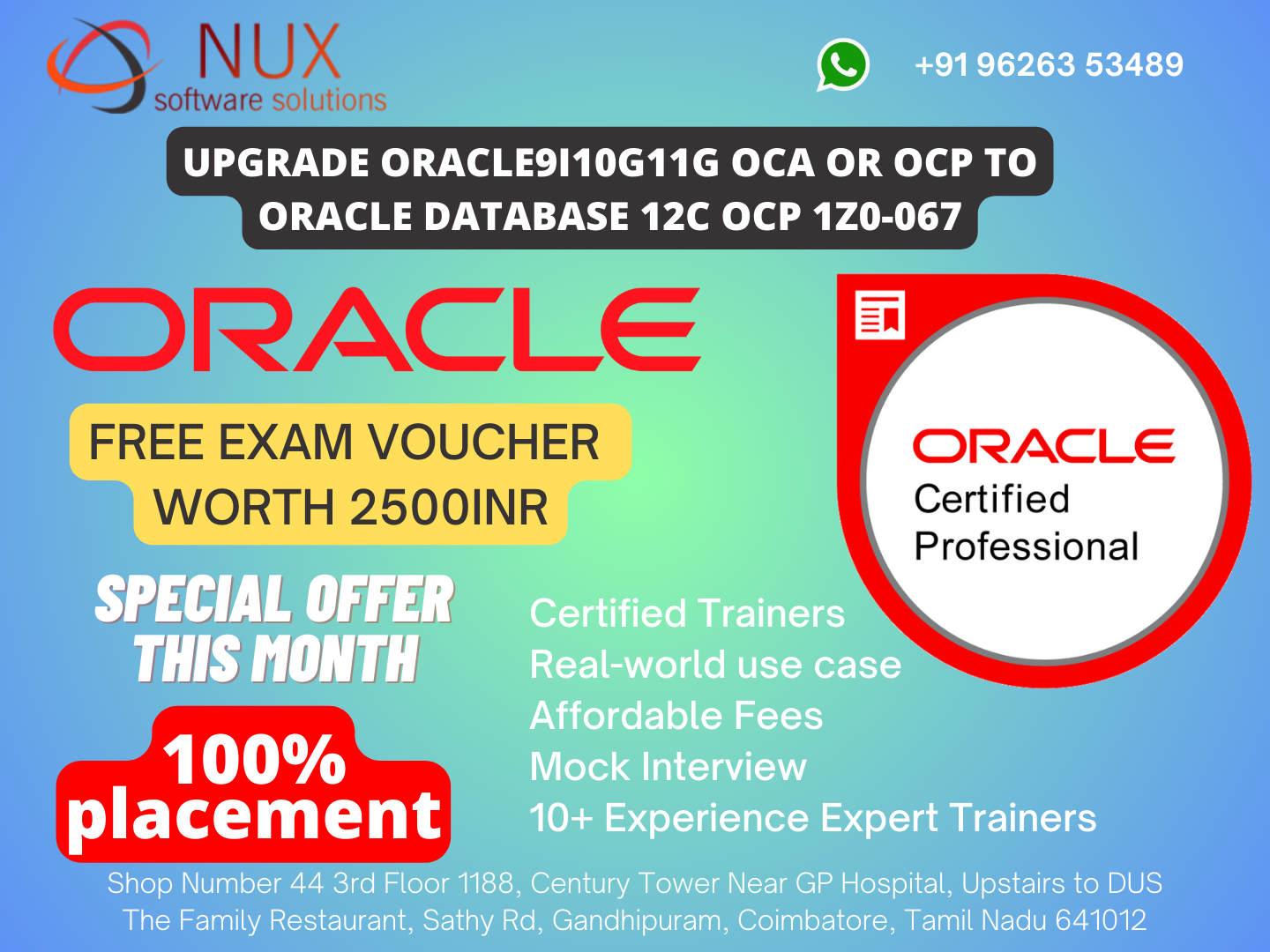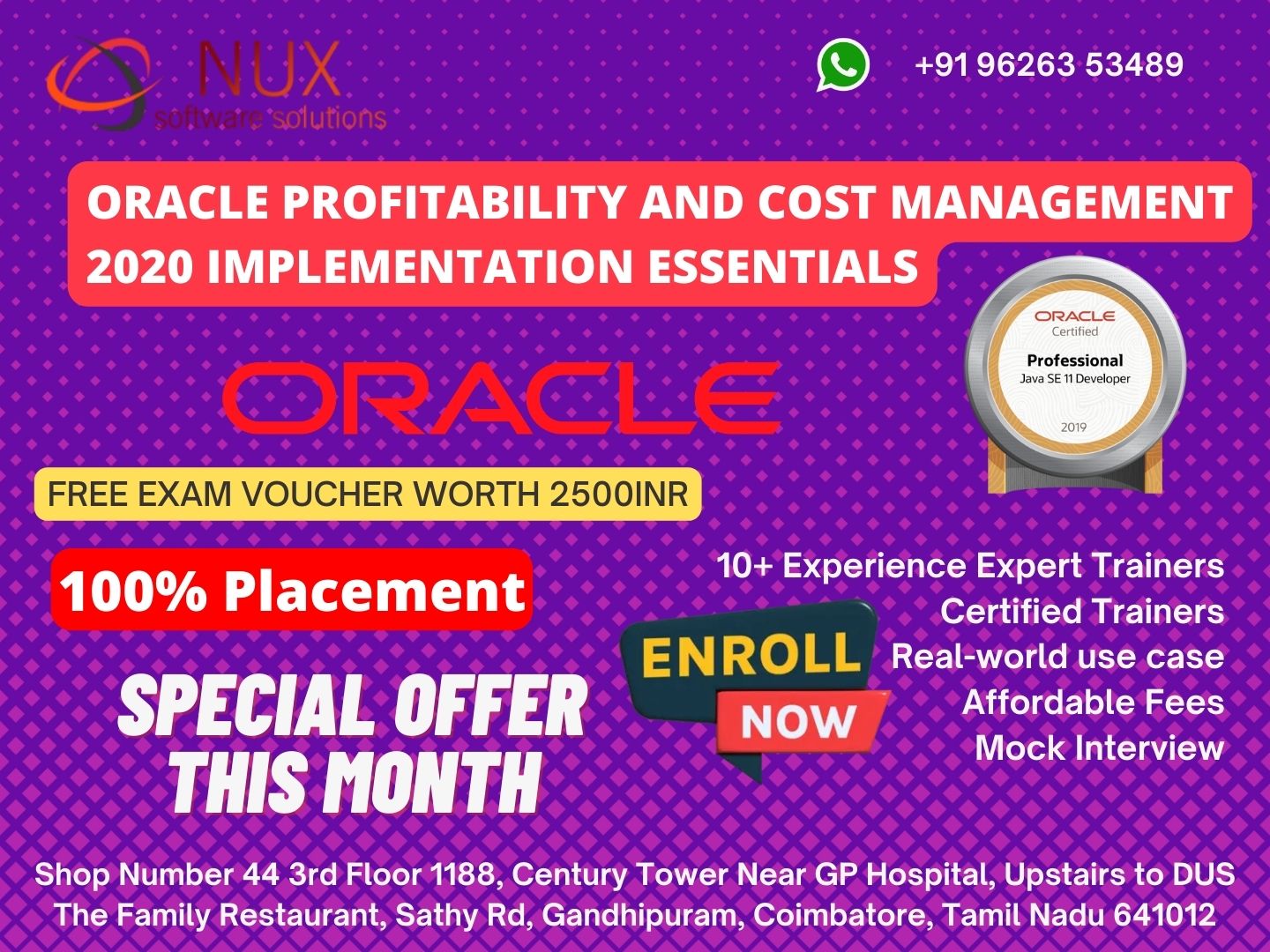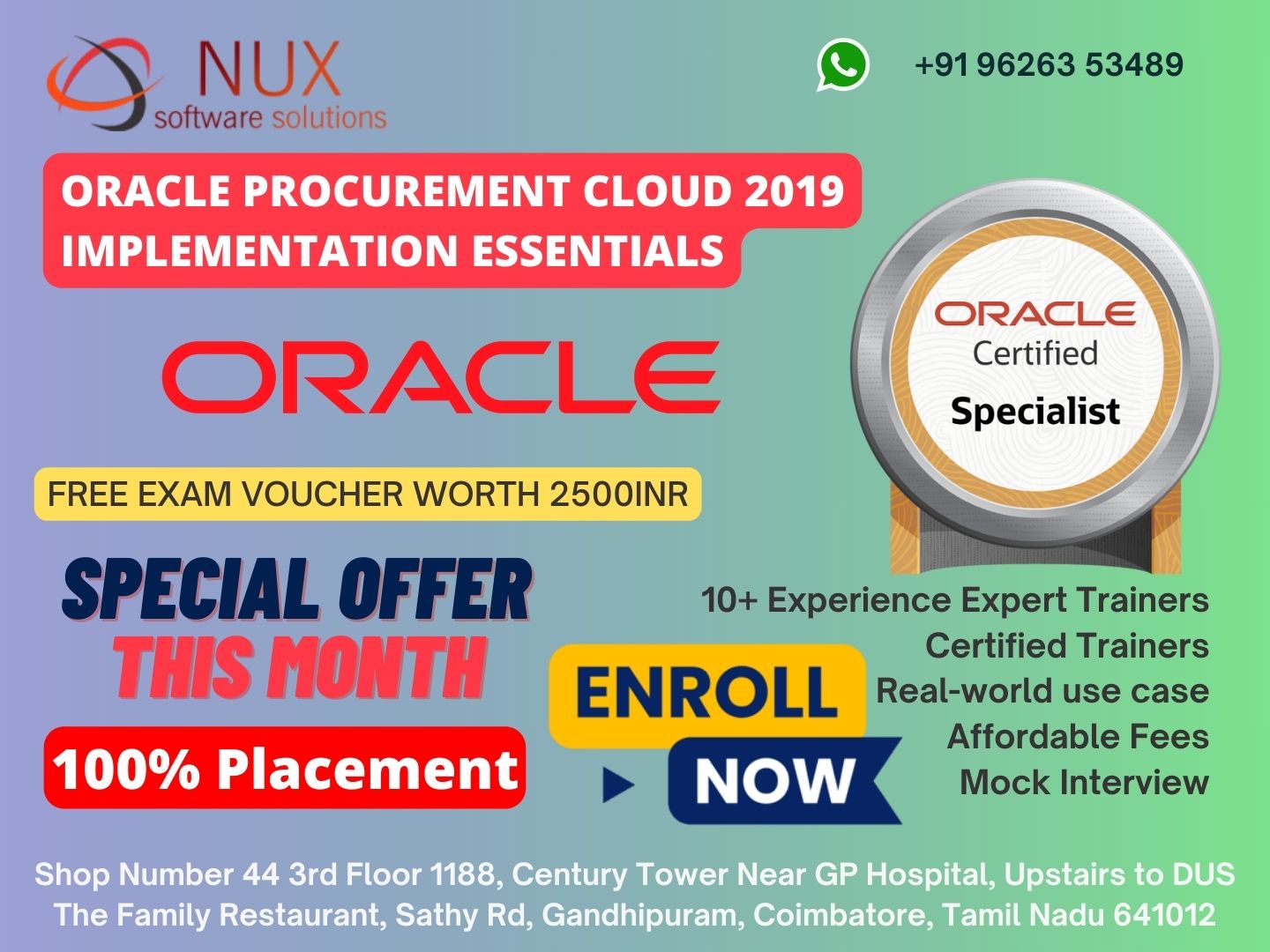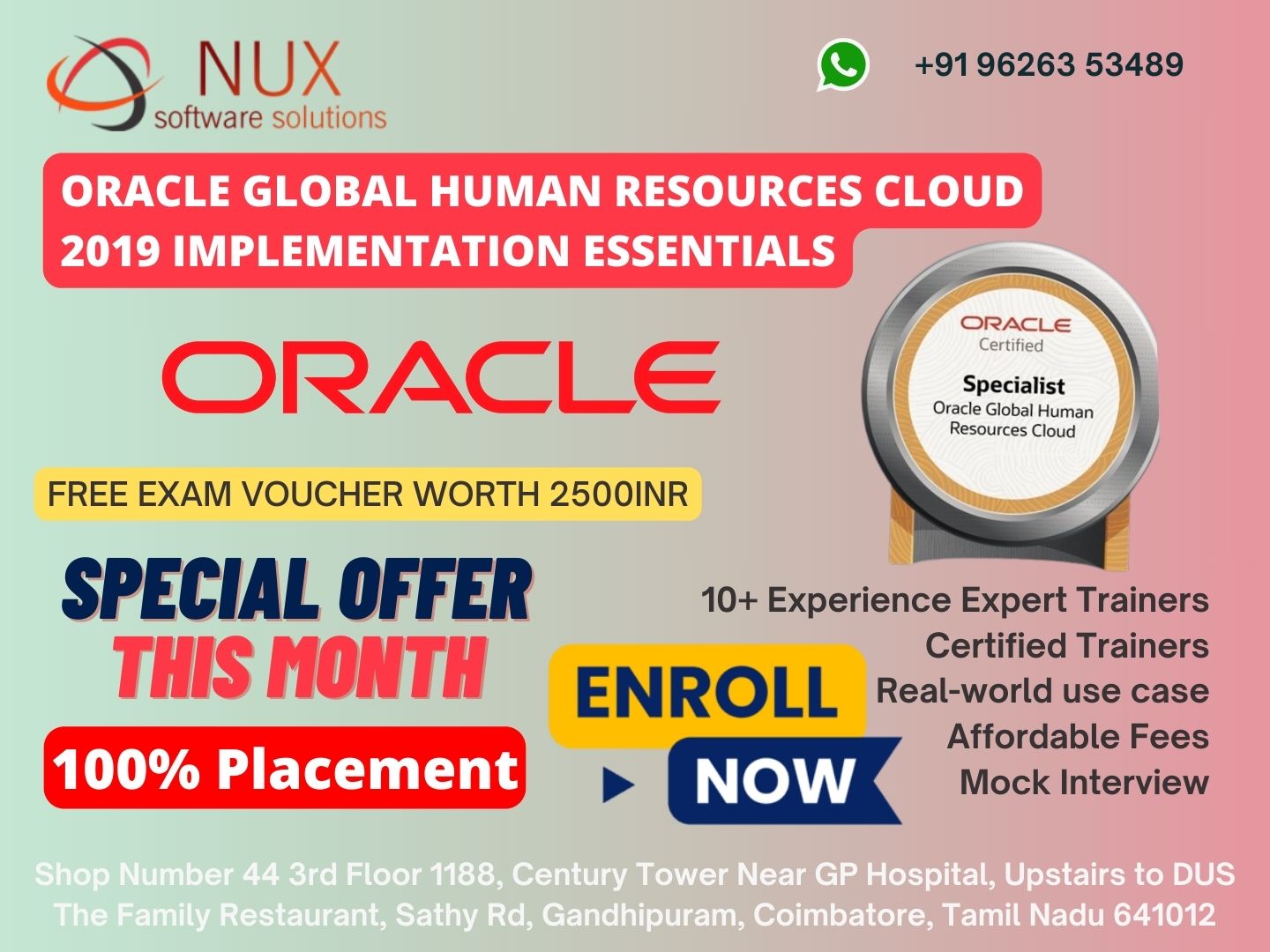Upgrade Oracle9i10g11g OCA OR OCP to Oracle Database 12c OCP1Z0-067


Best Upgrade Oracle9i10g11g OCA OR OCP to Oracle Database 12c OCP
1Z0-067 Certification training courses classes deliver by Nux software Training & Certification Solutions in coimbatore. Nux Software Training & Certification Solutions in coimbatore has excellent and advanced training programs that will give you better performance & hands on experience.
Our industry’s expert trainers offer a wide range of skills and experience in their graded areas. The Training center environment is too good for professional, individual, corporate, live project training and industrial training. Labs infrastructure is advanced, well managed and you can access LAB 24X7 from anywhere. Training center has international expert trainers and they have excellent knowledge, real time industry experience.
Our Training programs combine with several innovative learning methods and delivery models. We understand your requirement and it will give you 100 percent growth for your career and provide the cost effective training programs and also work with flexibility for the trainees.
Course Syllabus
Upgrade Oracle9i10g11g OCA OR OCP to Oracle Database 12c OCP 1Z0-067
Backup and Recovery
1. Explain Oracle backup and recovery solutions
Describe types of database failures
Describe the tools available for backup and recovery tasks
Describe RMAN and maximum availability architecture
Use the SYSBACK privilege
Use RMAN stand-alone and job commands
1. Back up and recover a NOARCHIVELOG database
Perform backup and recovery in NOARCHIVELOG mode
Use SQL in RMAN
1. Configure and manage RMAN settings
Configure database parameters that affect RMAN operations
Configure persistent settings for RMAN
View persistent settings
Specify a retention policy
2. Configure the Fast Recovery Area
Explain the Fast Recovery Area
Configure the Fast Recovery Area
3. Configure control files and redo log files for recoverability
Multiplex control files
Multiplex redo log files
1. Create and use an RMAN recovery catalog
Configure a recovery catalog
Register target databases in a recovery catalog
Catalog additional backup files
Resynchronize a recovery catalog
Use and maintain RMAN stored scripts
Upgrade and drop a recovery catalog
2. Protect the RMAN recovery catalog
Back up the recovery catalog
Re-create an unrecoverable recovery catalog
Export and import the recovery catalog
Create and use Virtual Private Catalogs
1. Use various RMAN backup types and strategies
Enable ARCHIVELOG mode
Create tape and disk based backups
Create whole database backups
Create consistent and inconsistent backups
Create backup sets and image copies
Create backups of read-only tablespaces
Employ best practices for data warehouse backups
1. Perform full and incremental backups
Create full and incremental backups
Use the Oracle-suggested backup strategy
2. Manage backups
Configure and monitor block change tracking
Report on backups using LIST, REPORT commands
Manage backups using CROSSCHECK, DELETE commands
1. Use techniques to improve backups
Create compressed backups
Create multi-section backups of very large files
Create proxy copies
Create duplexed backup sets
Create backups of backup sets
Create archival backups
2. Perform backup of non-database files
Back up a control file to trace
Back up archived redo log files
Back up ASM diskgroup metadata
1. Create RMAN-encrypted backups
2. Use transparent-mode encryption
3. Use password-mode encryption
4. Use dual-mode encryption
5. Restore encrypted backups
1. Describe the Automatic Diagnostic Workflow
Use the Automatic Diagnostic Repository
Use ADRCI
Find and interpret message output and error stacks
Use the Data Recovery Advisor
2. Handle block corruption
Detect block corruption using RMAN
Perform block recovery using RMAN
Detect database corruptions using the ANALYZE and DBVERIFY utility
Detect database corruptions using the DBMS_REPAIR package
Implement the DB_BLOCK_CHECKING parameter to detect corruptions
1. Describe and tune instance recovery
2. Perform complete and incomplete recovery
Use RMAN RESTORE and RECOVER commands
Restore ASM disk groups
Recover from media failures
Perform complete and incomplete or “point-in-time” recoveries using RMAN
Perform automated TSPITR
1. Perform recovery for spfile, control file, redo log files
2. Perform table recovery from backups
3. Perform recovery of index and read-only tablespaces, temp file
4. Restore a database to a new host
5. Recover using incrementally updated backups
6. Switch to image copies for fast recovery
7. Perform disaster recovery
1. Configure and use Oracle Secure Backup
1. Describe the Flashback technologies
Configure a database to use Flashback technologies
Guarantee undo retention
2. Use Flashback to query data
Use Flashback Query
Use Flashback Version Query
Use Flashback Transaction Query
Flash back a transaction
3. Perform Flashback Table operations
Perform Flashback Table
Restore tables from the recycle bin
4. Describe and use Flashback Data Archive
Use Flashback Data Archive
Use DBMS_FLASHBACK_ARCHIVE package
1. Perform Flashback Database
Configure Flashback Database
Perform Flashback Database
1. Describe and use transportable tablespaces and databases
Transport tablespaces between databases using image copies or backup sets
Transport databases using data files or backup sets
Transport data across platforms
1. Choose a technique for duplicating a database
From an active database, connected to the target and auxiliary instances
From backup, connected to the target and auxiliary instances
From backup, connected to the auxiliary instance, not connected to the target, but with recovery catalog connection
From backup, connected to the auxiliary instance, not connected to the target and the recovery catalog
Duplicate a database with RMAN
2. Create a backup-up based duplicate database
3. Duplicate a database based on a running instance
1. Tune RMAN performance
Interpret RMAN error stacks
Diagnose performance bottlenecks
Tune RMAN backup performance
1. Use Automatic Storage Management
Explain Automatic Storage Management (ASM)
Set up initialization parameter files for ASM and database instances
Administer ASM diskgroups
Execute SQL commands with ASM file names
Perform startup and shutdown for ASM instances
Use the ASMCMD command-line interface
Set up ASM fast mirror resynch
Use RMAN to migrate your database to ASM
1. Perform user-managed backup and recovery
Describe the backup mode
Back up and recover a control file
Recover from a lost temp file
Recover from a lost redo log group
Recover from the loss of a password file
Perform user-managed complete database recovery
Perform user-managed incomplete database recovery
Multitenant Environment
1. Describe multitenant architecture
2. Explain pluggable database provisioning
1. Create and configure a CDB
2. Create a PDB using different methods
3. Unplug and drop a PDB
4. Migrate a non-CDB to a PDB database
1. Establish connections to a CDB/PDB
2. Start up and shut down a CDB and open and close PDBs
3. Evaluate the impact of parameter value changes
1.Manage permanent and temporary tablespaces in CDB and PDBs
1. Manage common and local users
2. Manage common and local privileges
3. Manage common and local roles
4. Enable common users to access data in specific PDBs
1. Perform backups of a CDB and PDBs
2. Recover PDB from PDB datafiles loss
3. Use Data Recovery Advisor
4. Duplicate PDBs using RMAN
5. Perform Flashback for a CDB
1. Monitor operations and performance in a CDB and PDBs
2. Manage allocation of resources between PDBs and within a PDB
3. Perform Database Replay
1. Use Data Pump
2. Use SQL*Loader
3. Audit operations
4. Use other products with a CDB and PDBs: Database Vault, Data Guard, LogMiner
Database Administration
1. Install Oracle Grid Infrastructure for a stand-alone server
2. Install Oracle Database software
3. Use Oracle Restart
4. Upgrade to Oracle Database 12c
1. Use EM Express
2. Use DBCA to create and manage databases
3. Use Oracle Database Migration Assistant for Unicode
1. Implement Automatic Shared Memory Management
2. Manually configure SGA parameters for various memory components in the SGA
3. Use Automatic PGA Memory Management
4. Implement Automatic Memory Management
1. Create and maintain bigfile tablespaces
2. Rename tablespaces
3. Create a default permanent tablespace
1. Manage resumable space allocation
2. Reclaim wasted space from tables and indexes by using the segment shrink functionality
3. Rebuild indexes online
4. Reduce space-related error conditions by proactively managing tablespace usage
5. Use different storage options to improve the performance of querie
6. Use automatic undo retention tuning and temporary undo
7. Implement partitioning methods
1. Configure the password file to use case-sensitive passwords
2. Encrypt a tablespace
3. Use Secure File LOBS to store documents with compression, encryption, de-duplication
4. Configure fined-grained access to network services
5. Use and manage Oracle Data Redaction policies
1. Enable and configure standard and Unified Audit Data Trail
2. Create and enable audit policies
1. Use administrative privileges
1. Customize language-dependent behavior for the database and individual sessions
2. Specify different linguistic sorts for queries
3. Use datetime datatypes
4. Query data using non-case-sensitive and accent-insensitive searches
5. Obtain globalization support configuration information
1. Create a job, program, and schedule
2. Use a time-based or event-based schedule for executing Scheduler jobs
3. Create lightweight jobs
4. Use job chains to perform a series of related tasks
5. Create Windows and Job Classes
6. Use advanced Scheduler concepts to prioritize jobs
1. Explain Data Pump architecture
2. Monitor a Data Pump job
3. Use Data Pump export and import
4. Create external tables for data population
1. Configure the Resource Manager
2. Assign users to Resource Manager groups
3. Create resource plans within groups
4. Specify directives for allocating resources to consumer groups
1. Use the SQL Tuning Advisor
2. Use the SQL Access Advisor to tune a workload
3. Use Database Replay
4. Implement real-time database operation monitoring
5. Use Adaptive Execution Plans
6. Use enhanced features of statistics gathering
7. Use Adaptive SQL Plan Management
8. Perform emergency monitoring and real-time ADDM
9. Generate ADDM Compare Period (Use AWR and ADDM)
10. Diagnose performance issues using ASH enhancements
11. Explain Multiprocess and Multithreaded Oracle architecture
12. Use Flash Cache
1. Use ILM features
2. Perform tracking and automated data placement
3. Move a data file online
1. Differentiate between ILM and Valid-Time Temporal
2. Set and use Valid-Time Temporal
3. Use in-database archiving



